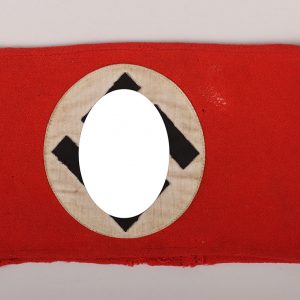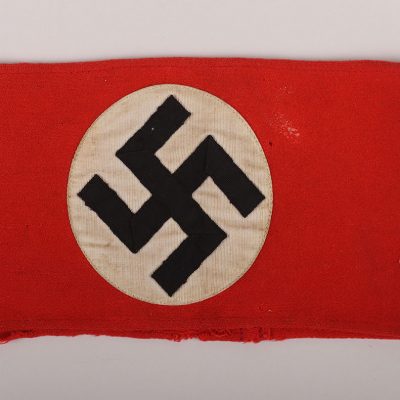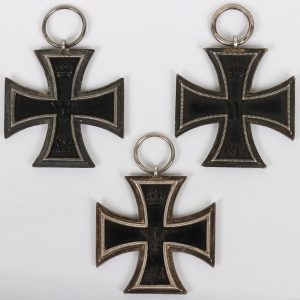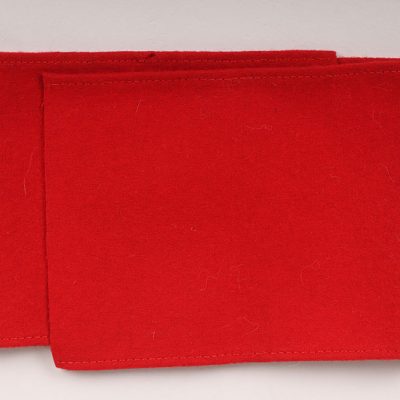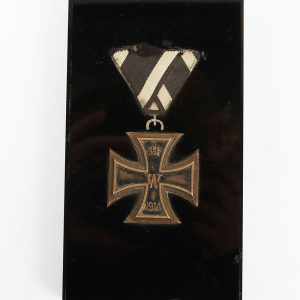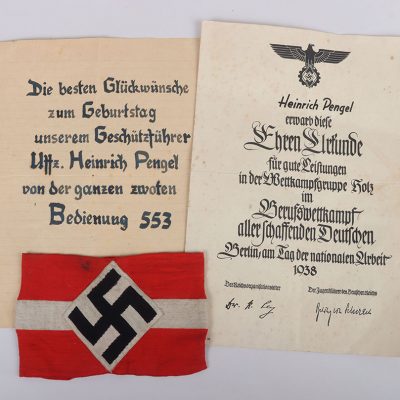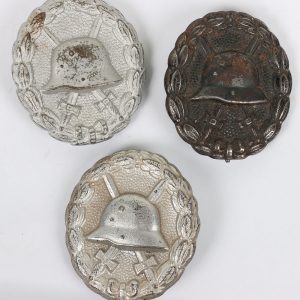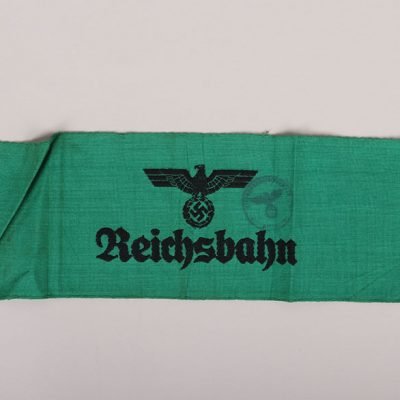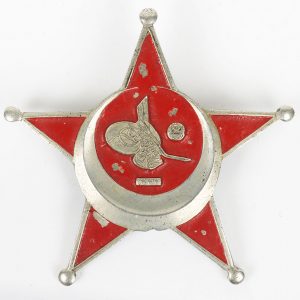Цены, указанные на сайте, могут быть изменены.
Для уточнения актуальных цен свяжитесь с нами или воспользуйтесь формой обратной связи.
Отображение 2273–2288 из 3607
Фильтры-
#371 – THIRD REICH SA DRESS DAGGER WITH INTERESTING DECAL LABEL FOR GAU WESTFALEN (Лот: 7723)
Ставки принимаются через менеджераTHIRD REICH SA DRESS DAGGER WITH INTERESTING DECAL LABEL FOR GAU WESTFALEN, nice example with wooden grip retaining nickel silver eagle and enamel SA emblem. Lower cross guard mount stamped ‘He’. The dagger is housed in scabbard with an interesting golden decal label which reads ‘Eigentum der Gauleitung Westfalen der NSDAP’ (Property of the Gauleitung of Westfalen of the NSDAP). Some paint loss to the scabbard. Double edged blade which remains in near mint condition with much of the original polish and cross graining. The blade has the windmill trademark of the maker Robert Herder Solingen. An interesting SA dress dagger.
-
#371 – 3rd Battalion Kings Own Scottish Borderers Regimental Drum (Лот: 8963)
Ставки принимаются через менеджера3rd Battalion Kings Own Scottish Borderers Regimental Drum, fine example of a regimental drum having polychrome decoration in the form of regimental scroll, battalion detail, regimental badge and battle honours up to WW2. With the original skins, glass top added to the top skin and the rope tension strings. Very good overall condition.
-
#372 – CIVIL WAR PERIOD CONFEDERATE PARADE FLAG (Лот: 7724)
Ставки принимаются через менеджераCIVIL WAR PERIOD CONFEDERATE PARADE FLAG, probably was used in parade sending the boys off to war! Or possibly coming back. The Stars & Bars (Saint Andrews Cross) design, is made of an early gauze like material which was dyed to make the double-sided color design, measures 17′ x 11 ½’, this attached to a 30′ round wooden pole, display well, condition is VG++
-
#372 – Royal Air Force Far East Flight Commemorative Folio for the flight of Four Supermarie-Napier Southampton Flying Boats 1927-28 (Лот: 8964)
Ставки принимаются через менеджераRoyal Air Force Far East Flight Commemorative Folio for the flight of Four Supermarie-Napier Southampton Flying Boats 1927-28, folio published to commemorate the 1927-1928 flight of four Supermarine-Napier ‘Southampton’ flying boats which successfully flew from Felixstowe to Singapore, departing 27 October 1927 arriving 28 February 1928. Contains two folio pages which have extracts from the official log of the flights which were commanded by Group Captain H. M. Cave-Browne-Cave, D.S.O. D.F.C. Four colour plates which show the personnel of the RAF Far East flight (identified on the reverse), Four Supermarine-Napier ‘Southampton’s’ at the Singapore Air Base, Officers of the RAF Far East Flight with model of the aircraft in front of them (identified below) and a Supermarine-Napier ‘Southampton’ in flight between Akyab and Rangoon. Each measures 45 ½ x 32cms approx.
-
#373 – NEW YORK STATE OFFICERS CHAPEAU CIRCA 1870, IN ORIGINAL BOX ID’D (Лот: 7725)
Ставки принимаются через менеджераNEW YORK STATE OFFICERS CHAPEAU CIRCA 1870, IN ORIGINAL BOX ID’D, is made of a black seal & beaver skin w/ black ostrich feather plume, black satin lining w/ gold embossed makers label ‘Harding , Costumes Regalia 30 Franklin St. Boston’, has a 1 ½’ black leather sweat band, has black ostrich feather trim, has a NY State brass seal on a black velour oval 3′ x 4′, on its box is the owner ‘LT. J.H. Curtis Rockdale N.Y.’ has a paper label for ‘Adams Express Company , Norwich N.Y.’, very attractive, VG++ – LOW EXC.
-
#373 – Nationally Important Gold Caterpillar Club Badge and Log Books of Air Vice Marshall Donald Bennett CB, CBE, DSO, Royal Air Force, Commander of the Pathfinder Force During WW2 (Лот: 8965)
Ставки принимаются через менеджераNationally Important Gold Caterpillar Club Badge and Log Books of Air Vice Marshall Donald Bennett CB, CBE, DSO, Royal Air Force, Commander of the Pathfinder Force During WW2, Caterpillar Club badge in gold with ruby eyes, reverse engraved ‘WC/CDR D C T BENNETT’. Brooch pin fitting to the reverse. Accompanying the badge are eight original Royal Air Force and Civilian Flying Log Books belonging to Bennett, the log books cover pre-war, wartime and post war period. The logs cover his time training with the RAF and also his time serving with the Imperial Airways. The most interesting from a wartime period is his civilian log book titled as ‘4’, this log has the entry on 27th April 1942, which states he was ‘Shot down low level attack on Tirpitz’ and the last entry in the log on 5th July 1942, ‘Appointed to Command Path Finder Force’. The logs are well filled out with many interesting details, including his involvement in the Berlin Airlift. eing sold by direct family descent of Air Vice Marshall Bennett. onald Bennett was born the youngest son of a grazier and business agent in Queensland, Australia. He attended Brisbane Grammar School. After some time working in his father’s business, he joined the Royal Australian Air Force in 1930, qualifying at RAAF Point Crook as a pilot. He transferred to the RAF a year later. Starting with the flying Boats of no 210 Squadron. Bennett developed a passion for accurate flying and precise navigation that would never leave him. After a period as an instructor, he left the service in 1935, retaining a reserve commission, to join Imperial Airways. Over the next five years, Bennett specialised in long-distance flights, breaking a number of records and pioneering techniques which would later become commonplace, notably air to air refuelling. In July 1938 he piloted the Mercury part of the Short Mayo Composite flying-boat across the Atlantic; this flight earned him the Oswald Watt Gold Medal for that year.uring 1940 Bennett was involved in setting up the Atlantic Ferry Crossing, bringing many aircraft over from the USA to the UK. In 1941 he was recommissioned into the Royal Air Force Volunteer Reserve as a Squadron Leader. Promoted to Wing Commander, he was posted to command No77 Squadron, as part of Bomber Command. In April 1942, No. 77 Squadron was transferred to Coastal Command and Bennett was given command of No. 10 Squadron (Handley Page Halifax) and shortly afterwards led a raid on the German battleship Tirpitz. Shot down during that raid, he evaded capture and escaped to Sweden, from where he was able to return to Britain; he and his copilot were awarded the Distinguished Service Order (DSO) on 16 June 1942. It was for this raid on the Tirpitz which resulted in the award of the Caterpillar Club badge. n July 1942, Bennett was appointed to command the new Pathfinder Force (PFF), an elite unit tasked with improving RAF Bomber Command’s navigation. At this stage of the war, Bomber Command had begun to make night-time raids deep into Germany, but had not yet been able to cause significant damage, largely because only about a quarter of the bomb loads were delivered “on target” — and this at a time when “on target” was defined as within three miles of the aim point. Bennett was called to Bomber Command HQ when he was on the point of leaving with his squadron for the Middle East. There he was informed by Sir Arthur Harris (Bomber Harris), that he was to lead a special force to make use of the new bombing and navigational aids then available and the more sophisticated ones that would follow. With effect from 5 July he was promoted to group captain. In 1943 Bennett was promoted with the upgrading of PFF to group status to air commodore, and then in December to acting air vice marshal, the youngest ever to hold that rank, giving him a rank similar to those of the other commanders of groups. He remained in command of the Pathfinder Force until the end of the war, overseeing its growth to an eventual 19 squadrons, a training flight and a meteorological flight, working relentlessly to improve its standards, and tirelessly campaigning for better equipment, in particular for more Mosquitos and Lancasters to replace the diverse assortment of often obsolete aircraft with which the force started.
-
#374 – WW2 Royal Canadian Air Force Flying Log Book of Warrant Officer G H Jenkins Navigator and Air Gunner with 415 & 524 Squadron (Лот: 8966)
Ставки принимаются через менеджераWW2 Royal Canadian Air Force Flying Log Book of Warrant Officer G H Jenkins Navigator and Air Gunner with 415 & 524 Squadron, the RCAF log book begins in 1943 when he began training on various aircraft. In June 1944 he was posted to No 415 Squadron flying in Wellington Bombers with Flight Lieutenant Meggison, he was the Navigator. In July 1944 he along with Flt Lt Meggison were moved to No 524 Squadron, still flying Wellington Bombers, they took part in operations over the Belgium and Dutch coasts. On the 27th July he notes ‘DOCKING – THORNEY ISLAND ‘W’ PATROL DIEPPE MANY ROBOT BOMBS SEEN – A NUMBER OBSERVED SHOT DOWN’. On August 11th 1944 he remarks on the fact they were chased by Night Figher. They continued on operations in the area throughout August, September and October, with various entries in the log book covering these missions and the various successes. On the 8th November 1944, during an armed reconnaissance mission they were shot up by a night fighter and 4 foot of their tail plane shot off. In December 1944 they were also attacked badly and it is noted in the log book that on the 5th December, the pilots escape hatch was blown off. In 1945 they continued with various operations, including against anti-midget submarines. The final operation was on the night of 3rd / 4th May 1945. Jenkins continued to serve into the immediate post war years with 86 Squadron. Further research accompanies the log book.
